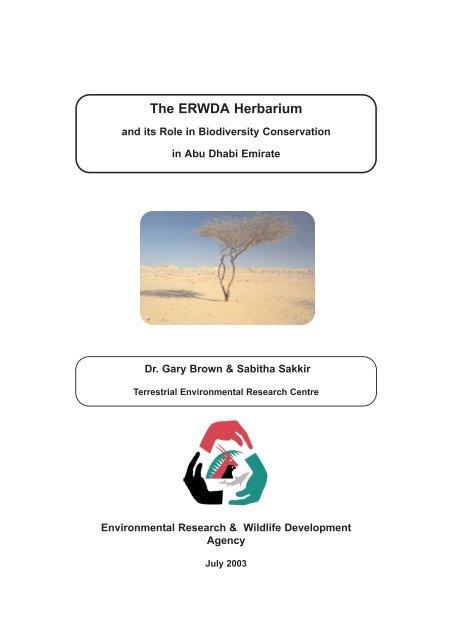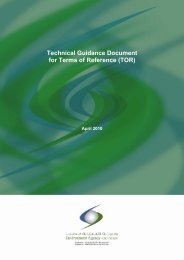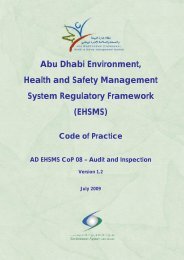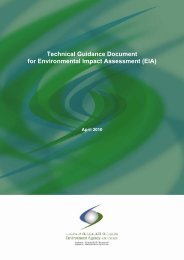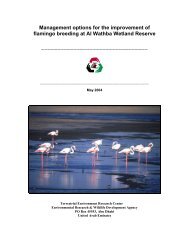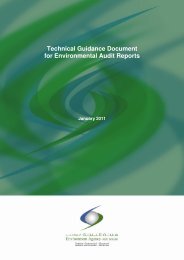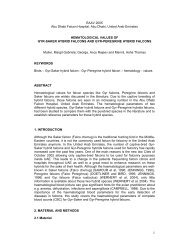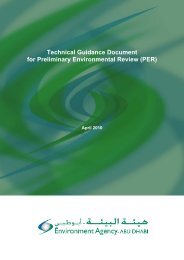The ERWDA Herbarium
The ERWDA Herbarium
The ERWDA Herbarium
You also want an ePaper? Increase the reach of your titles
YUMPU automatically turns print PDFs into web optimized ePapers that Google loves.
<strong>The</strong> <strong>ERWDA</strong> <strong>Herbarium</strong><br />
and its Role in Biodiversity Conservation<br />
in Abu Dhabi Emirate<br />
Dr. Gary Brown & Sabitha Sakkir<br />
Terrestrial Environmental Research Centre<br />
Environmental Research & Wildlife Development<br />
Agency<br />
July 2003
<strong>The</strong> <strong>ERWDA</strong> <strong>Herbarium</strong><br />
and its Role in Biodiversity Conservation<br />
in Abu Dhabi Emirate<br />
Dr. Gary Brown and Sabitha Sakkir<br />
Contents<br />
1. Introduction . . . . . . . . . . . . . . . . . . . . . . . . . . . . . . . . . . . . . . . . . . . . . . . . . .3<br />
2. History of the <strong>ERWDA</strong> <strong>Herbarium</strong> . . . . . . . . . . . . . . . . . . . . . . . . . . . . . . . . .3<br />
3. Main objectives of the <strong>ERWDA</strong> <strong>Herbarium</strong> . . . . . . . . . . . . . . . . . . . . . . . . . .4<br />
4. Current size of the <strong>ERWDA</strong> <strong>Herbarium</strong> . . . . . . . . . . . . . . . . . . . . . . . . . . . . .5<br />
5. Collection and processing of specimens for the <strong>ERWDA</strong> herbarium . . . . . . . .5<br />
5.1. Collection of specimens . . . . . . . . . . . . . . . . . . . . . . . . . . . . . . . . . . . . . . . .5<br />
5.2. Pressing and drying of specimens . . . . . . . . . . . . . . . . . . . . . . . . . . . . . . . . .6<br />
5.3. Mounting of specimens . . . . . . . . . . . . . . . . . . . . . . . . . . . . . . . . . . . . . . . . .6<br />
5.4. Storage of specimens . . . . . . . . . . . . . . . . . . . . . . . . . . . . . . . . . . . . . . . . . .7<br />
5.5. Other storage methods . . . . . . . . . . . . . . . . . . . . . . . . . . . . . . . . . . . . . . . . .7<br />
5.6. Decontamination of specimens . . . . . . . . . . . . . . . . . . . . . . . . . . . . . . . . . . .8<br />
6. Identification of specimens . . . . . . . . . . . . . . . . . . . . . . . . . . . . . . . . . . . . . .8<br />
7. Outlook . . . . . . . . . . . . . . . . . . . . . . . . . . . . . . . . . . . . . . . . . . . . . . . . . . . . . . . .9<br />
Acknowledgments . . . . . . . . . . . . . . . . . . . . . . . . . . . . . . . . . . . . . . . . . . . . . . . . .10<br />
Appendix A (List of species in the <strong>ERWDA</strong> <strong>Herbarium</strong>) . . . . . . . . . . . . . . . . . . . . . .11
1. Introduction<br />
A herbarium is a collection of properly identified,<br />
dried and pressed plants that are<br />
mounted on sheets of stout paper. Each<br />
sheet can hold one or several specimens<br />
of a single species, and a label provides<br />
information on various aspects of the specimen.<br />
In professional herbaria, the sheets<br />
are stored in special, insect-proof cupboards,<br />
and are usually arranged according<br />
to the country in which they were collected,<br />
followed by family, genus and<br />
species. In this manner, it is possible to<br />
store plants for substantial periods of time,<br />
using a minimum amount of space.<br />
Furthermore, storing plants in a systematic<br />
manner allows specimens to be easily<br />
accessed and retrieved.<br />
<strong>Herbarium</strong> specimens can be used for a<br />
variety of purposes, most commonly<br />
though for identification, as described in<br />
more detail below. As specimens may be<br />
up to several hundreds of years old, collections<br />
of plants can give detailed insight into<br />
prevailing environmental conditions in the<br />
past, especially if the labels on the sheets<br />
contain adequate information. One of the<br />
more ‘exotic’ uses of herbarium specimens<br />
is to compare pollution levels in the past<br />
with those of the present day. This technique<br />
has, for instance, been successfully<br />
applied to comparing past and current<br />
heavy metal concentrations in the environment.<br />
2. History of the <strong>ERWDA</strong> <strong>Herbarium</strong><br />
A first collection of plant species from the<br />
UAE under the auspices of <strong>ERWDA</strong> (then<br />
NARC) was initiated by Benno Böer in<br />
1994. <strong>The</strong> specimens, representing 249<br />
species, were deposited in Sweihan at<br />
NARC. <strong>The</strong> identification of many of these<br />
plants was confirmed (or carried out, as in<br />
the case of unknown species) by a number<br />
of internationally renowned experts. <strong>The</strong>re<br />
were no elaborate facilities available to<br />
process and store plants at the time, and<br />
with the move to the Maqta Bridge site, it<br />
proved impossible to store the plants effectively<br />
and prevent damage to them by<br />
insects. <strong>The</strong>re were also no funds available<br />
to finance manpower to maintain the collection.<br />
Sadly, the entire valuable collection<br />
was devoured by insects and therefore lost<br />
(Böer, oral communication).<br />
In 2001, a small herbarium was re-established<br />
by TERC at <strong>ERWDA</strong> HQ in a small<br />
room that doubles up as a laboratory.<br />
Proper storage cabinets were purchased,<br />
and funds were made available to obtain<br />
necessary consumables. Ms. Sabitha<br />
Sakkir has been responsible for the everyday<br />
running of the <strong>ERWDA</strong> <strong>Herbarium</strong><br />
since 2001.<br />
- 3 -
3. Main objectives of the <strong>ERWDA</strong><br />
<strong>Herbarium</strong><br />
<strong>The</strong> primary objective of the <strong>ERWDA</strong><br />
<strong>Herbarium</strong> is to serve as a reference collection<br />
to aid in plant identification, a vital<br />
function in biodiversity conservation given<br />
the lack of a proper flora for the region and<br />
the general paucity of floristic knowledge.<br />
<strong>The</strong> scientifically reliable identification of<br />
specimens is essential to a number of<br />
major projects being carried out in<br />
<strong>ERWDA</strong>, mainly by TERC, MERC and also<br />
NARC. This is not just necessary for identifying<br />
individual plants, but for assessing<br />
the vegetation of specific areas.<br />
Fig. 2. Herbaria provide a wealth of vital information<br />
for the preparation of floras and wildflower<br />
guides, including this one!<br />
Other objectives of the <strong>ERWDA</strong> <strong>Herbarium</strong><br />
can be summarised as follows:<br />
- to develop identification tools for<br />
species in the Emirate;<br />
- to document species collected in specific<br />
locations of interest;<br />
Fig. 1. Only by collecting ‘critical’ species such<br />
as Tribulus arabicus s.l. for herbaria will their<br />
precise identity be unravelled one day.<br />
Information obtained from the <strong>ERWDA</strong><br />
<strong>Herbarium</strong> also played a key role in the<br />
review process of the book ”Wildflowers of<br />
the UAE” which was recently published by<br />
<strong>ERWDA</strong> (Fig. 2).<br />
- to gain insight into plant diversity and<br />
distribution of species within the<br />
Emirate;<br />
- to obtain information on the threat status<br />
species for the development of a<br />
UAE Red List of endangered plants.<br />
In view of the limited amount of floristic<br />
information from the Emirate, the specific<br />
activities to which the herbarium directly<br />
contributes relate predominantly to Goal 5<br />
in the Environmental Strategy and Action<br />
Plan of <strong>ERWDA</strong>, especially to Steps 5.1.<br />
- 4 -
(Conduct a quantitative baseline survey of<br />
the location and distribution of natural<br />
wildlife resources in the Emirate), 5.2.<br />
(Identify hot-spots for high priority conservation<br />
efforts), 5.3. (Develop a Red List of<br />
Endangered Plants and Animals), 5.4.<br />
(Ecosystem Monitoring), 5.5. (Manage and<br />
develop Protected Areas), 5.6. (Develop<br />
and apply action plans for Flagship species<br />
requiring specific actions), 5.9. (Invasive<br />
species) and 5.11. (Research).<br />
It should be emphasised that it is not the<br />
aim of the <strong>ERWDA</strong> <strong>Herbarium</strong> to establish<br />
a fully comprehensive collection of plants<br />
from the Emirate comprising numerous<br />
specimens of each species as a tool for<br />
carrying out taxonomic research. This<br />
should be left to academic institutes with<br />
the appropriate financial, space and human<br />
resources.<br />
4. Current size of the <strong>ERWDA</strong><br />
<strong>Herbarium</strong><br />
<strong>The</strong> <strong>ERWDA</strong> <strong>Herbarium</strong> currently houses a<br />
collection of about 600 sheets. 286 plant<br />
species belonging to 50 dicot and 7 monocot<br />
families are represented in the herbarium.<br />
A list of these species is given in<br />
Appendix A.<br />
5. Collection and processing of specimens<br />
for the <strong>ERWDA</strong> <strong>Herbarium</strong><br />
5.1. Collection of specimens<br />
Plant specimens are usually collected during<br />
the course of various projects that<br />
involve fieldwork. Only in rare cases<br />
though are specific plant collecting trips<br />
organised, as this is currently not one of<br />
the main focuses of TERC work.<br />
Specimens collected in the field are kept in<br />
tightly sealed plastic bags in a coolbox until<br />
they can be processed. Notes are made on<br />
the precise collecting locality (with GPS<br />
coordinates), as well as on details of the<br />
plant that may become indistinct after<br />
pressing (e.g. petal colour).<br />
In addition, the herbarium receives specimens<br />
from people outside of <strong>ERWDA</strong>. A<br />
large number of mounted sheets were<br />
recently received from Marijcke Jongbloed,<br />
a former resident of Dubai, who collected<br />
extensively over many years. We also<br />
hope to involve more actively interested<br />
persons from the Emirates Natural History<br />
Group in Abu Dhabi to assist in collecting,<br />
especially on their regular field trips.<br />
Recently, we have begun cooperating<br />
more intensely with external institutions<br />
involved in similar work. For instance,<br />
since 2003, we are now working with scientists<br />
from the Zayed Complex for Herbal<br />
Research and Traditional Medicine who<br />
- 5 -
also maintain a herbarium. In this manner,<br />
we are able to exchange information and<br />
plant specimens, and therefore use the limited<br />
financial and manpower resources at<br />
our disposal more efficiently to achieve our<br />
specific objectives.<br />
5.2. Pressing and drying of specimens<br />
On returning to the laboratory, the specimens<br />
are carefully pressed between<br />
sheets of newspaper in a plant press (see<br />
Fig. 3). It is advisable to put sheets of blotting<br />
paper and cardboard between the<br />
plants to ensure that air can circulate effectively,<br />
and the specimens dry reasonably<br />
quickly. This also limits the risk of fungal<br />
attack. Drying is best performed at temperatures<br />
between about 30 °C and 40 °C,<br />
and takes up to two to three weeks. Rapid<br />
drying at high temperatures in an oven is<br />
still fresh may result in them becoming<br />
stewed.<br />
5.3. Mounting<br />
Once pressed and dried, the plant specimens<br />
are mounted with labels on special<br />
archival 11x17 inch paper. <strong>The</strong> mounting<br />
process involves careful work with attention<br />
to detail, to ensure that all identifying<br />
characteristics are highlighted. A mounted<br />
herbarium specimen is shown in Fig. 4.<br />
Each herbarium sheet is furnished with a<br />
label (Fig. 5) which gives precise information<br />
on the name of the species, collection<br />
locality, habitat, date of collection, along<br />
with some brief ecological data. In addition,<br />
Fig. 3. <strong>Herbarium</strong> press.<br />
not recommended, as it can lead to specimens<br />
becoming too brittle. High temperatures<br />
applied to the plants when they are<br />
Fig. 4. Typical herbarium sheet with Reseda<br />
aucheri. <strong>The</strong> label in the bottom right-hand corner<br />
gives important details on the plant (see<br />
Fig. 5).<br />
- 6 -
a later date (e.g. due to changes in nomenclature,<br />
taxonomic status, misidentification),<br />
the views of the original person who<br />
carried out identification can be taken into<br />
account and assessed.<br />
5.4. Storage of specimens<br />
Fig. 5. Label on the herbarium sheet shown in<br />
Fig. 4 giving important details.<br />
the name of the person who identified the<br />
species is clearly stated. This is standard<br />
practice, because should any queries arise<br />
as to the identity of a particular species at<br />
Once the specimens are properly mounted,<br />
they are placed into folders to protect them<br />
against abrasive damage. <strong>The</strong>se folders<br />
are then stored in a metal cabinet (Fig. 6)<br />
with sealed doors to prevent insects from<br />
entering. <strong>The</strong> folders are arranged alphabetically<br />
according to family and genus.<br />
5.5. Other storage methods<br />
Some species, or individual organs of<br />
plants, cannot be pressed or stored effectively<br />
in a herbarium. Examples include<br />
members of the broomrape family (e.g.<br />
Cistanche tubulosa), with their fleshy<br />
stems that turn brown on drying (Fig. 7).<br />
Often, it is more convenient, or indeed the<br />
Fig. 6. <strong>Herbarium</strong> cabinet containing herbarium<br />
sheets in protective folders. <strong>The</strong>se are<br />
stored according to family, genus and species<br />
allowing easy retrieval.<br />
Fig. 7. Cistanche tubulosa, a fleshy parasitic<br />
species, does not press well and is more conveniently<br />
stored in spirits.<br />
- 7 -
only method, to preserve such specimens<br />
in spirits (Fig. 8).<br />
returned to room temperature for five days,<br />
after which they are refrozen for a further<br />
two days. Only then are specimens placed<br />
back in the cabinets.<br />
6. Identification of specimens<br />
Fig. 8. Species or particular organs of plants<br />
that do not press well are often best preserved<br />
in spirits.<br />
5.6. Decontamination of specimens<br />
Long-term preservation of herbarium specimens<br />
involves constant attention to protect<br />
them from damage by pests. Most commonly,<br />
dried plants become infested with<br />
small beetles, and these can cause great<br />
damage to specimens within a short period<br />
of time. For this reason, it is important<br />
that specimens are routinely checked for<br />
the presence of insect pests, and are<br />
decontaminated at regular intervals.<br />
Rather than use chemical agents, which<br />
may be harmful to human health, we use<br />
the simple, but effective method of freezing.<br />
For this purpose, bundles of dried<br />
specimens are placed in sealed plastic<br />
bags and left in a freezer at -18 °C for two<br />
days. Following this treatment, they are<br />
Identification of specimens is an important<br />
process that requires skill and experience.<br />
Specimens can often be identified before<br />
they are pressed with appropriate identification<br />
aids, such as floras, manuals and<br />
monographs. However, as already stated,<br />
there is no definitive work on the plants of<br />
the UAE, and so we are reliant on literature<br />
from adjacent regions (including NE<br />
Africa and the Mediterranean) for identification.<br />
<strong>The</strong> recent acquisition of a highquality<br />
stereo microscope mounted on a<br />
special stand to enable the easy viewing of<br />
Fig. 9. A stereo microscope is an indispensible<br />
piece of equipment for identification purposes.<br />
Mounting it on a cross boom allows herbarium<br />
sheets to be conveniently examined. <strong>The</strong><br />
external cold light source (left) provides illumination<br />
of a similar spectrum to that of daylight,<br />
and does not heat the specimens.<br />
- 8 -
specimens on herbarium sheets (Figs. 9 &<br />
10) will greatly facilitate our task of providing<br />
an identification service to meet<br />
<strong>ERWDA</strong>’s needs.<br />
At present, we are able to cope with the<br />
number of species and the amount of time<br />
required to maintain the herbarium. As it<br />
increases in size though, it may prove necessary<br />
to employ further manpower, possibly<br />
on a part-time basis, especially if the<br />
one member of staff currently responsible<br />
for running the herbarium is assigned to<br />
duties on other projects.<br />
Fig. 10. Close-up of the Zeiss SV6 stereo<br />
microscope recently obtained for the <strong>ERWDA</strong><br />
herbarium.<br />
7. Outlook<br />
When sufficient specimens have been collected,<br />
it may prove advisable to send certain<br />
‘difficult’ groups to appropriate specialists<br />
for confirmation of their identity. In this<br />
manner, we will receive feedback on our<br />
identification success, the presence of possible<br />
new species, as well as an update on<br />
recent taxonomic developments.<br />
Now that most major items of equipment<br />
have been purchased, the actual running<br />
of the herbarium requires little in the way<br />
of financial resources. <strong>The</strong>se are needed<br />
mainly for purchasing consumables, such<br />
as mounting paper, blotting paper, glue,<br />
etc. However, a further metal storage cabinet<br />
may be required next year to house<br />
additional specimens. Furthermore, a suitable<br />
camera would be a valuable asset, in<br />
order that specimens can be photographed,<br />
digitised and made accessible<br />
on the <strong>ERWDA</strong> web site and<br />
Environmental Database. A CD ROM version<br />
of the Index Kewensis, an alphabetical<br />
listing of all plant names with bibliographic<br />
references to the place of their first publication,<br />
would be a useful tool for checking<br />
the correct names of species.<br />
Later in the year, we will be liaising with the<br />
IT Department of <strong>ERWDA</strong> to create a proper<br />
database entry form, so that information<br />
on the herbarium specimens can be inte-<br />
- 9 -
grated into the <strong>ERWDA</strong> Environmental<br />
Database.<br />
Acknowledgments: We would like to<br />
thank <strong>ERWDA</strong> Management and the<br />
Director of TERC, John Newby, for continuing<br />
support of the <strong>Herbarium</strong>. We are<br />
grateful to those persons who have<br />
assisted in collecting specimens.<br />
Authors’ address:<br />
<strong>ERWDA</strong>, TERC, PO Box 45553, Abu<br />
Dhabi, UAE<br />
gbrown@erwda.gov.ae<br />
ssakkir@erwda.gov.ae<br />
Appendix A overleaf.<br />
- 10 -
Appendix A. List of plant species in the <strong>ERWDA</strong> <strong>Herbarium</strong> (30.6.2003). Plants are listed<br />
according to family, genus and species.<br />
No. Species Family<br />
1 Blepharis ciliaris (L.) B.L. Burtt Acanthaceae<br />
2 Adiantum capillus-veneris L. Adiantaceae<br />
3 Cheilanthes pteriodioides (Richard) C. Chr. Adiantaceae<br />
4 Onychium divaricatum (Poir.) Alston Adiantaceae<br />
5 Aizoon canariense L. Aizoaceae<br />
6 Mesembryanthemum nodiflorum L. Aizoaceae<br />
7 Sesuvium verrucosum Raf. Aizoaceae<br />
8 Trianthema cf. portulacastrum L. Aizoaceae<br />
9 Zaleya pentandra (L.) C. Jeffrey Aizoaceae<br />
10 Achyranthes aspera L. Amaranthaceae<br />
11 Aerva javanica (Burm. F.) Juss. Ex Schult. Amaranthaceae<br />
12 Amaranthus albus L. Amaranthaceae<br />
13 Amaranthus graecizans L. Amaranthaceae<br />
14 Amaranthus hybridus L. Amaranthaceae<br />
15 Amaranthus lividus L. Amaranthaceae<br />
16 Amaranthus viridis L. Amaranthaceae<br />
17 Pistacia khinjuk Stocks Anacardiaceae<br />
18 Nerium oleander L. Apocynaceae<br />
19 Nanorrhops ritchieana (Griffith) Aitch. Arecaceae<br />
20 Calotropis procera (Aiton) W.T. Aiton Asclepiadaceae<br />
21 Glossonema varians (Stocks) J. D. Hook. Asclepiadaceae<br />
22 Leptadenia pyrotechnica (Forssk.) Decne. Asclepiadaceae<br />
23 Pentatropis spiralis (Forssk.) Decne. Asclepiadaceae<br />
24 Pergularia tomentosa L. Asclepiadaceae<br />
25 Periploca aphylla Decne. Asclepiadaceae<br />
26 Rhazya stricta Decne. Asclepiadaceae<br />
27 Asphodelus tenuifolius (Cav.) Baker Asphodelaceae<br />
28 Aegopordon berardoides Boiss. Asteraceae<br />
29 Anthemis odontostephana Boiss. Asteraceae<br />
- 11 -
30 Anvillea garcinii (Burm. F.) DC. Asteraceae<br />
31 Blumea bovei (DC.) Vatke Asteraceae<br />
32 Calendula arvensis L. Asteraceae<br />
33 Centaurea pseudosinaica Czerep. Asteraceae<br />
34 Centaurea wendelboi Wagen. Asteraceae<br />
35 Conyza bonariensis (L.) Cronq. Asteraceae<br />
36 Echinops sp. Asteraceae<br />
37 Filago desertorum Pomel Asteraceae<br />
38 Flaveria trinervia (Spreng.) Mohr Asteraceae<br />
39 Helichrysum makranicum (Rech. F. & Esfand.) Rech. F. Asteraceae<br />
40 Ifloga spicata (Forssk.) Sch. Bip. Asteraceae<br />
41 Iphiona aucheri (Boiss.) A. Anders Asteraceae<br />
42 Iphiona scabra Decne. Asteraceae<br />
43 Lactuca serriola L. Asteraceae<br />
44 Launaea capitata (Spreng.) Dandy Asteraceae<br />
45 Launaea massauensis (Fres.) Chiov. Asteraceae<br />
46 Launaea mucronata (Forssk.) Muschl. Asteraceae<br />
47 Launaea nudicaulis (L.) Hook. F. Asteraceae<br />
48 Launaea procumbens (Roxb.) Ram. & Raj. Asteraceae<br />
49 Pentanema divaricatum Cass. Asteraceae<br />
50 Phagnalon viridifolium Decne. Asteraceae<br />
51 Pluchea arabica (Boiss.) Kaiser & Lack Asteraceae<br />
52 Pluchea dioscoridis (L.) DC. Asteraceae<br />
53 Pseudognaphalium luteoalbum (L.) Hill. & Burtt Asteraceae<br />
54 Pulicaria arabica (L.) Cass. Asteraceae<br />
55 Pulicaria edmondsonii Gamal-Eldin Asteraceae<br />
56 Pulicaria glutinosa Jaub. & Spach Asteraceae<br />
57 Rhanterium epapposum Oliv. Asteraceae<br />
58 Seriphidium herba-alba (Asso) Y.R.Li Asteraceae<br />
59 Sonchus oleraceus L. Asteraceae<br />
60 Sonchus tenerrimus L. Asteraceae<br />
61 Urospermum picroides (L.) F.W. Schmidt Asteraceae<br />
62 Vernonia arabica F.G. Davies Asteraceae<br />
63 Vernonia cinerea (L.) Less. Asteraceae<br />
64 Avicennia marina (Forssk.) Vierh. Avicenniaceae<br />
65 Tecomella undulata (Roxb.) Seem Bignoniaceae<br />
66 Anchusa aegyptiaca (L.) DC. Boraginaceae<br />
- 12 -
67 Anchusa hispida Forssk. Boraginaceae<br />
68 Arnebia hispidissima (Lehm.) DC. Boraginaceae<br />
69 Arnebia linearifolia DC. Boraginaceae<br />
70 Cordia sinensis Lam. Boraginaceae<br />
71 Echiochilon kotschyi (Boiss. & Hohen.) I.M.Johnst. Boraginaceae<br />
72 Echiochilon persicum (Burm. F.) I.M.Johnst. Boraginaceae<br />
73 Heliotropium bacciferum Forssk. Boraginaceae<br />
74 Heliotropium calcareum Stocks. Boraginaceae<br />
75 Heliotropium curassavicum L. Boraginaceae<br />
76 Heliotropium digynum (Forssk.) Asch. Ex C. Chr. Boraginaceae<br />
77 Heliotropium europaeum L. Boraginaceae<br />
78 Heliotropium lasiocarpum Fisch. & C.A. Mey. Boraginaceae<br />
79 Heliotropium ramosissimum (Lehm.) DC. Boraginaceae<br />
80 Moltkiopsis ciliata (Forssk.) I.M. Johnst. Boraginaceae<br />
81 Ogastemma pusillum (Coss.& Dur.) Brum. Boraginaceae<br />
82 Trichodesma ehrenbergii Schweinf. ex Boiss. Boraginaceae<br />
83 Trichodesma eretotrichum R.R. Mill Boraginaceae<br />
84 Cardaria draba (L.) Desv. Brassicaceae<br />
85 Coronopus didymus (L.) Sm. Brassicaceae<br />
86 Diplotaxis harra (Forssk.) Boiss. Brassicaceae<br />
87 Eremobium aegyptiacum (Spreng.) Boiss. Brassicaceae<br />
88 Eruca sativa Mill. Brassicaceae<br />
89 Erucaria hispanica (L.) Druce Brassicaceae<br />
90 Farsetia aegyptia Turra Brassicaceae<br />
91 Farsetia linearis Decne. ex Boiss. Brassicaceae<br />
92 Farsetia longisiliqua Decne. Brassicaceae<br />
93 Farsetia stylosa R. Br. Brassicaceae<br />
94 Morettia parviflora Boiss. Brassicaceae<br />
95 Notoceras bicorne (Aiton) Amo Brassicaceae<br />
96 Physorrhynchus chamaerapistrum (Boiss.) Boiss. Brassicaceae<br />
97 Sisymbrium erysimoides Desf. Brassicaceae<br />
98 Zilla spinosa (L.) Prantl Brassicaceae<br />
99 Capparis cartilaginea Decne. Capparaceae<br />
100 Capparis spinosa L. Capparaceae<br />
101 Cleome austroarabica ssp. mascatensis Cham. & Lam. Capparaceae<br />
102 Cleome noeana Boiss. Capparaceae<br />
103 Cleome quinquenervia DC. Capparaceae<br />
- 13 -
104 Cleome rupicola Vicary Capparaceae<br />
105 Cleome scaposa DC. Capparaceae<br />
106 Dipterygium glaucum Decne. Capparaceae<br />
107 Cometes surattensis L. Caryophyllaceae<br />
108 Gymnocarpos decandrus Forssk. Caryophyllaceae<br />
109 Gypsophila bellidifolia Boiss. Caryophyllaceae<br />
110 Polycarpaea repens (Forssk.) Asch. & Schweinf. Caryophyllaceae<br />
111 Polycarpaea spicata Wight ex Arn. Caryophyllaceae<br />
112 Sclerocephalus arabicus Boiss. Caryophyllaceae<br />
113 Spergula fallax (Lowe) E.H.L. Krause Caryophyllaceae<br />
114 Spergularia marina (L.) Bessler Caryophyllaceae<br />
115 Casuarina equisetifolia J.R.& G.Frost Casuarinaceae<br />
116 Anabasis setifera Moq. Chenopodiaceae<br />
117 Arthrocnemum macrostachyum (Moric.) Mor. & Del. Chenopodiaceae<br />
118 Atriplex leucoclada Boiss. Chenopodiaceae<br />
119 Bassia eriophora (Schrad.) Asch. Chenopodiaceae<br />
120 Chenopodium album L. Chenopodiaceae<br />
121 Chenopodium murale L. Chenopodiaceae<br />
122 Cornulaca arabica Botsch. Chenopodiaceae<br />
123 Cornulaca monacantha Delile Chenopodiaceae<br />
124 Halocnemum strobilaceum (Pall.) M. Bieb. Chenopodiaceae<br />
125 Halopeplis perfoliata (Forssk.) Bunge ex Asch. Chenopodiaceae<br />
126 Haloxylon persicum Bunge Chenopodiaceae<br />
127 Haloxylon salicornicum (Moq.) Bunge ex Boiss. Chenopodiaceae<br />
128 Salicornia europaea L. Chenopodiaceae<br />
129 Salsola drummondii Ulbr. Chenopodiaceae<br />
130 Salsola imbricata Forssk. Chenopodiaceae<br />
131 Salsola rubescens Franch. Chenopodiaceae<br />
132 Seidlitzia rosmarinus Ehrenb.ex Bunge Chenopodiaceae<br />
133 Suaeda aegyptiaca (Hassel.) Zoh. Chenopodiaceae<br />
134 Suaeda vermiculata Forssk. ex J.F.Gmel Chenopodiaceae<br />
135 Helianthemum lippii (L.) Dum.Cours. Cistaceae<br />
136 Convolvulus arvensis L. Convolvulaceae<br />
137 Convolvulus cephalopodus Boiss. Convolvulaceae<br />
138 Citrullus colocynthis (L.) Schrad. Cucurbitaceae<br />
139 Cynomorium coccineum L. Cynomoriaceae<br />
140 Cladium mariscus (L.) Pohl Cyperaceae<br />
- 14 -
141 Cyperus arenarius Retz. Cyperaceae<br />
142 Cyperus conglomeratus Rottb. Cyperaceae<br />
143 Cyperus rotundus L. Cyperaceae<br />
144 Eleocharis geniculata (L.) Roem. & Schult. Cyperaceae<br />
145 Fimbristylis bisumbellata (Forssk.) Buban. Cyperaceae<br />
146 Fimbristylis ferruginea (L.) Vahl Cyperaceae<br />
147 Schoenus nigricans L. Cyperaceae<br />
148 Scabiosa olivieri Coult. Dipsacaceae<br />
149 Chrozophora oblongifolia (Delile) Spreng. Euphorbiaceae<br />
150 Chrozophora plicata (Vahl.) Juss. ex Spreng. Euphorbiaceae<br />
151 Euphorbia granulata Forssk. Euphorbiaceae<br />
152 Euphorbia hirta L. Euphorbiaceae<br />
153 Euphorbia larica Boiss. Euphorbiaceae<br />
154 Alhagi graecorum Boiss. Fabaceae<br />
155 Argyrolobium roseum (Camb.) Jaub. & Spach Fabaceae<br />
156 Crotalaria aegyptiaca Benth. Fabaceae<br />
157 Hippocrepis constricta Kunze Fabaceae<br />
158 Hippocrepis unisiliquosa L. Fabaceae<br />
159 Indigofera arabica Burm. f. Fabaceae<br />
160 Indigofera argentea L. Fabaceae<br />
161 Indigofera articulata Gouan Fabaceae<br />
162 Indigofera colutea (Burm.f.) Merrill Fabaceae<br />
163 Indigofera intricata Boiss. Fabaceae<br />
164 Indigofera oblongifolia Forssk. Fabaceae<br />
165 Lotononis platycarpa (Viv.) Pic.-Serm. Fabaceae<br />
166 Lotus garcinii DC. Fabaceae<br />
167 Medicago polymorpha L. Fabaceae<br />
168 Rhynchosia schimperi Hochst. & Boiss. Fabaceae<br />
169 Senna italica Mill. Fabaceae<br />
170 Taverniera glabra Boiss. Fabaceae<br />
171 Taverniera lappacea (Forssk.) DC. Fabaceae<br />
172 Tephrosia apollinea (Delile) DC. Fabaceae<br />
173 Tephrosia nubica (Boiss.) Bak. Fabaceae<br />
174 Erodium glaucophyllum (L.) L’Her. Geraniaceae<br />
175 Erodium malacoides (L.) L’Her. Geraniaceae<br />
176 Monsonia nivea (Decne.) Webb Geraniaceae<br />
177 Juncus rigidus Desf. Juncaceae<br />
- 15 -
178 Lavandula subnuda Benth. Lamiaceae<br />
179 Leucas inflata Benth. Lamiaceae<br />
180 Teucrium stocksianum Boiss. Lamiaceae<br />
181 Muscari longipes Boiss. Liliaceae<br />
182 Lawsonia inermis L. Lythraceae<br />
183 Acridocarpus orientalis A. Juss. Malphigiaceae<br />
184 Malva parviflora L. Malvaceae<br />
185 Acacia ehrenbergiana Hayne Mimosaceae<br />
186 Acacia tortilis (Forssk.) Hayne Mimosaceae<br />
187 Prosopis cineraria (L.) Druce Mimosaceae<br />
188 Prosopis juliflora (Sw.) DC. Mimosaceae<br />
189 Gisekia pharnaceoides L. Molluginaceae<br />
190 Limeum arabicum Friedr. Molluginaceae<br />
191 Limeum obovatum Vicary Molluginaceae<br />
192 Ficus salicifolia Vahl Moraceae<br />
193 Moringa peregrina (Forssk.) Fiori Moringaceae<br />
194 Neurada procumbens L. Neuradaceae<br />
195 Boerhavia elegans Choisy Nyctaginaceae<br />
196 Epipactis veratrifolia Boiss. Orchidaceae<br />
197 Cistanche tubulosa (Schenk) Wight Orobanchaceae<br />
198 Oxalis corniculata L. Oxalidaceae<br />
199 Plantago ciliata Desf. Plantaginaceae<br />
200 Plantago ovata Forssk. Plantaginaceae<br />
201 Dyerophytum indicum (Gibs ex Wight) Kuntze Plumbaginaceae<br />
202 Limonium axillare (Forssk.) Kuntze Plumbaginaceae<br />
203 Aeluropus lagopoides (L.) Trin. Poaceae<br />
204 Aristida abnormis Chiov. Poaceae<br />
205 Aristida adscensionis L. Poaceae<br />
206 Arundo donax L. Poaceae<br />
207 Brachypodium distachyon (L.) P. Beauv. Poaceae<br />
208 Bromus pectinatus Thunb. Poaceae<br />
209 Cenchrus ciliaris L. Poaceae<br />
210 Cenchrus echinatus L. Poaceae<br />
211 Cenchrus setigerus Vahl Poaceae<br />
212 Centropodia forsskalii (Vahl) Cope Poaceae<br />
213 Centropodia fragilis (Guinet & Sauvage) Cope Poaceae<br />
214 Chloris barbata Swartz Poaceae<br />
- 16 -
215 Chloris gayana Kunth. Poaceae<br />
216 Chloris virgata Swartz Poaceae<br />
217 Coelachyrum brevifolium (Hochst.) Nees Poaceae<br />
218 Coelachyrum piercii (Benth.) Bor Poaceae<br />
219 Cutandia memphitica (Spreng.) Boiss. Poaceae<br />
220 Cymbopogon schoenanthus (L.) Spreng. Poaceae<br />
221 Cymbopogon commutatus (Steud.) Stapf Poaceae<br />
222 Cynodon dactylon (L.) Pers. Poaceae<br />
223 Dactyloctenium aegyptium (L.) P. Beauv. Poaceae<br />
224 Dichanthium foveolatum (Dellle) Roberty Poaceae<br />
225 Digitaria sanguinalis (L.) Scop. Poaceae<br />
226 Echinochloa colona (L.) Link Poaceae<br />
227 Eragrostis barrelieri Daveau Poaceae<br />
228 Eragrostis cilianensis (All.) Vign. Poaceae<br />
229 Eragrostis ciliaris (L.) R. Br. Poaceae<br />
230 Hyparrhenia hirta (L.) Stapf. Poaceae<br />
231 Imperata cylindrica (L.) Beauv. Poaceae<br />
232 Lasiurus scindicus Henrard Poaceae<br />
233 Melanocenchris abyssinica (R.Br.ex Fresen.) Hochst. Poaceae<br />
234 Oryzopsis holciformis (M.Bieb.) Haeckel Poaceae<br />
235 Panicum antidotale Retz. Poaceae<br />
236 Panicum turgidum Forssk. Poaceae<br />
237 Pennisetum divisum (J.F. Gmel.) Henrard Poaceae<br />
238 Pennisetum orientale Rich. Poaceae<br />
239 Pennisetum setaceum (Forssk.) Chiov. Poaceae<br />
240 Phalaris canariensis L. Poaceae<br />
241 Phalaris minor Retz. Poaceae<br />
242 Phragmites australis (Cav.) Trin. ex Steud. Poaceae<br />
243 Polypogon monspeliensis (L.) Desf. Poaceae<br />
244 Saccharum ravennae (L.) Murr. Poaceae<br />
245 Setaria verticillata (L.) P. Beauv. Poaceae<br />
246 Setaria viridis (L.) P. Beauv. Poaceae<br />
247 Sporobolus ioclados (Nees ex Trin.) Nees Poaceae<br />
248 Sporobolus spicatus (Vahl) Kunth Poaceae<br />
249 Stipa capensis Thunb. Poaceae<br />
250 Stipagrostis ciliata (Desf.) de Winter Poaceae<br />
251 Stipagrostis plumosa (L.) Munro ex T. Anders. Poaceae<br />
- 17 -
252 Tragus racemosus (L.) All. Poaceae<br />
253 Tricholaena teneriffae (L.f.) Parl. Poaceae<br />
254 Polygala erioptera DC. Polygalaceae<br />
255 Calligonum comosum L’Her. Polygonaceae<br />
256 Calligonum crinitum Boiss. ssp. arabicum Sos. Polygonaceae<br />
257 Emex spinosa (L.) Campd. Polygonaceae<br />
258 Portulaca olereaca L. subsp. olereaca Portulacaceae<br />
259 Ochradenus baccatus Del. Resedaceae<br />
260 Oligomeris linifolia (Vahl) J.F. Macbr. Resedaceae<br />
261 Reseda aucheri Boiss. Resedaceae<br />
262 Ziziphus spina-christi (L.) Willd. Rhamnaceae<br />
263 Gaillonia aucheri (Guill.) Jaub. & Spach Rubiaceae<br />
264 Kohautia caespitosa Schinzl. Rubiaceae<br />
265 Pseudogaillonia hymenostephana (Jaub.&Spach) Lincz. Rubiaceae<br />
266 Haplophyllum tuberculatum (Forssk.) A. Juss. Rutaceae<br />
267 Salvadora persica L. Salvadoraceae<br />
268 Lindenbergia indica O. Kuntze Scrophulariaceae<br />
269 Schweinfurthia papilionacea (Burm. f.) Boiss. Scrophulariaceae<br />
270 Scrophularia deserti Delile Scrophulariaceae<br />
271 Nicotiana plumbaginifolia Viv. Solanaceae<br />
272 Tamarix arabica Bunge Tamaricaceae<br />
273 Corchorus depressus (L.) Stocks. Tiliaceae<br />
274 Forsskaolea tenacissima L. Urticaceae<br />
275 Fagonia bruguieri DC. Zygophyllaceae<br />
276 Fagonia indica Burm. f. Zygophyllaceae<br />
277 Fagonia ovalifolia Hadidi Zygophyllaceae<br />
278 Seetzenia lanata (Willd.) Bullock Zygophyllaceae<br />
279 Tribulus arabicus Hosni Zygophyllaceae<br />
280 Tribulus macropterus Boiss. Zygophyllaceae<br />
281 Tribulus omanense Hosni Zygophyllaceae<br />
282 Tribulus pentandrus Forssk. Zygophyllaceae<br />
283 Tribulus terrestris L. Zygophyllaceae<br />
284 Zygophyllum mandavillei Hadidi Zygophyllaceae<br />
285 Zygophyllum qatarense Hadidi Zygophyllaceae<br />
286 Zygophyllum simplex L. Zygophyllaceae<br />
- 18 -


